Content
Pollard's p-1 Method
Characteristic of Pollard's p-1 Method by
PowerSmooth Number
Pollard's P-1 Methed by Smooth Number Example 4
Pollard's p-1 Method
Pollard's p-1 method is a prime factorization algorithm discovered by John Pollard in 1974. Limited by the algorithm, the Pollard's p-1 method is only work for integers with specific factors.
However, since the composite number n is an unknown, sometimes, the algorithm may return a false response. Besides caused by finding all prime factors simulatanously due to a large B, the Polloard's p-1 method will also fail because of the pseudoprime like property.
Characteristic of Pollard's p-1 Method by PowerSmooth Number
The advantage of Pollard's p-1 method by powersmooth number is the checking of a group of primes with one computation. Every boundary B represents a group of numbers that can be expressed as the product of prime power factors less than and equal to number B.
However, since the composite number n is an unknown, sometimes, the algorithm may return a false response. For example:
Pollard's P-1 Methed by Smooth Number Example 4
For example: n=533=p*q=13*41; let B=5 imply
| Integer | B-smooth number | Prime Factors | number |
|---|---|---|---|
| k | 5 | 22*31*51 = 4*3*5 | 60 |
Therefore for B=5, k5 or (p5-1)m5 is equal to 60.
Fermat's Little Theorem
let a=2, by Fermat's little theorem, let p be one of the prime factors of n, imply p divides ak-1.
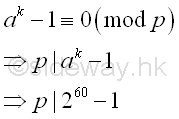
Greatest Common Divisor
Since ak-1 is a very large number, before finding the greatest common divisor of n and ak-1, ak-1 can be raised to the high power modulo n. Imply
Using squarings modulo
| base | number; a=2; k=60; n=533 |
|---|---|
| ak base 10 | 260 |
| ai base 10 | 21 = 21 ≡ 2 (mod 533) |
| 22 = 22 ≡ 4 (mod 533) | |
| 24 = 42 ≡ 16 (mod 533) | |
| 28 = 162 ≡ 256 (mod 533) | |
| 216 = 2562 ≡ 510 (mod 533) | |
| 232 = 5102 ≡ 529 (mod 533) | |
| ak base 10 | 232+16+8+4 |
| ak base 10 | 232*216*28*24 |
| ak base 10 | 529*510*256*16 ≡ 1 (mod 533) |
Imply

The algorithm returns a fail response, because the number n divides ak-1 and n is the greatest common divisor of n and ak-1. Imply
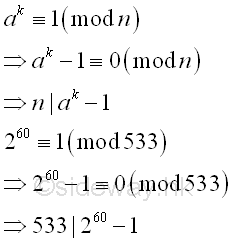
Therefore every prime factor of number n divides ak-1, imply
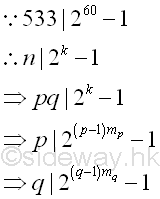
For this case, since k is not large enough to be the common multiple of p-1 and q-1, imply
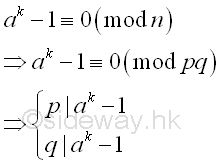
Therefore, one way is to select another a so that ak-1 is not the common multiple of both p and q. Let a=3, and B=5 Imply
| Integer | B-smooth number | Prime Factors | number |
|---|---|---|---|
| k | 5 | 22*31*51 = 4*3*5 | 60 |
Therefore for B=5, k5 or (p5-1)m5 is equal to 60.
Fermat's Little Theorem
let a=3, by Fermat's little theorem, let p be one of the prime factors of n, imply p divides ak-1.
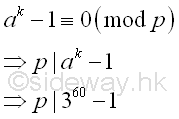
Greatest Common Divisor
Since ak-1 is a very large number, before finding the greatest common divisor of n and ak-1, ak-1 can be raised to the high power modulo n. Imply
Using squarings modulo
| base | number; a=3; k=60; n=533 |
|---|---|
| ak base 10 | 360 |
| ai base 10 | 31 = 31 ≡ 3 (mod 533) |
| 32 = 32 ≡ 9 (mod 533) | |
| 34 = 92 ≡ 81 (mod 533) | |
| 38 = 812 ≡ 165 (mod 533) | |
| 316 = 1652 ≡ 42 (mod 533) | |
| 332 = 422 ≡ 165 (mod 533) | |
| ak base 10 | 332+16+8+4 |
| ak base 10 | 332*316*38*34 |
| ak base 10 | 165*42*165*81 ≡ 40 (mod 533) |
Imply

The greatest common divisor of n and ak-1 is
Using Euclid's algorithm
| ak-1 | n |
|---|---|
| 360-1 | 533 |
| 40-1 | 533 |
| 39 | 533-13*39=26 |
| 39-26=13 | 26 |
| 13 | 26-2*13=0 |
| 13 | 0 |
Imply
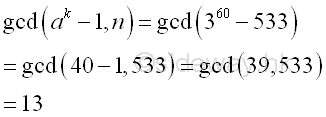
Integer 13, the greatest common divisor of n and ak-1 is also the prime divisor of n. And p-1 is 5-smooth. For a=2
| Integer | B-smooth number | Prime Factors | number |
|---|---|---|---|
| p-1 | 4,5 | 22*31 | 12 |
| q-1 | 5 | 23*51 | 40 |
| k5 | 5 | 22*31*51 = 4*3*5 | 60 |
| k5/(p-1) | 20*30*51 | 5 | |
| k5/(p-1)(q-1) | 20*30*50/23*30*50 | 1/8 |
Besides, for B=5; a=2 and a=3
| Integer | Prime Factors | number |
|---|---|---|
| p | 13 | 13 |
| q | 41 | 41 |
| n | 13*41 | 533 |
| 2k-1 | 32*52*71*111*131*311* 411*611*1511*3311*13211 | 1152921504606846975 |
| 3k-1 | 24*52*71*112*131*311*611*731* 2711*11811*45611*477633611 | 42391158275216203514294433200 |
| (2k-1)/pq | 32*52*71*111*131*310* 410*611*1511*3311*13211 | 2163079745979075 |
| (3k-1)/pq | 24*52*71*112*130*311*611*731* 2711*11811*45611*477633611 | 3260858328862784885714956400 /41 |
©sideway
ID: 120500012 Last Updated: 5/19/2012 Revision: 0
Latest Updated Links
- Travel Singapore Sight Space(last updated On 12/30/2025)
- Travel Singapore Sight Curiosity Cove(last updated On 12/30/2025)
- Travel Singapore Sight Night Safari(last updated On 12/30/2025)
- Travel Singapore Sight River Wonders(last updated On 12/30/2025)
- Travel Singapore Sight Rainforest Wild ASIA(last updated On 12/30/2025)
- Travel Singapore Sight Singapore Zoo(last updated On 12/30/2025)
- Travel Singapore Sight Mandai(last updated On 12/30/2025)
- Travel Singapore Sight Bird Paradise(last updated On 12/30/2025)
- Travel Singapore Sight AltitudeX(last updated On 12/30/2025)
- Travel Singapore Sight(last updated On 12/6/2025)
- Travel Singapore Rail Network(last updated On 12/5/2025)

 Nu Html Checker
Nu Html Checker  53
53  na
na  na
na
Home 5
Business
Management
HBR 3
Information
Recreation
Hobbies 9
Culture
Chinese 1097
English 339
Travel 31
Reference 79
Hardware 54
Computer
Hardware 259
Software
Application 213
Digitization 37
Latex 52
Manim 205
KB 1
Numeric 19
Programming
Web 289
Unicode 504
HTML 66
CSS 65
SVG 46
ASP.NET 270
OS 431
DeskTop 7
Python 72
Knowledge
Mathematics
Formulas 8
Set 1
Logic 1
Algebra 84
Number Theory 206
Trigonometry 31
Geometry 34
Calculus 67
Engineering
Tables 8
Mechanical
Rigid Bodies
Statics 92
Dynamics 37
Fluid 5
Control
Acoustics 19
Natural Sciences
Matter 1
Electric 27
Biology 1
